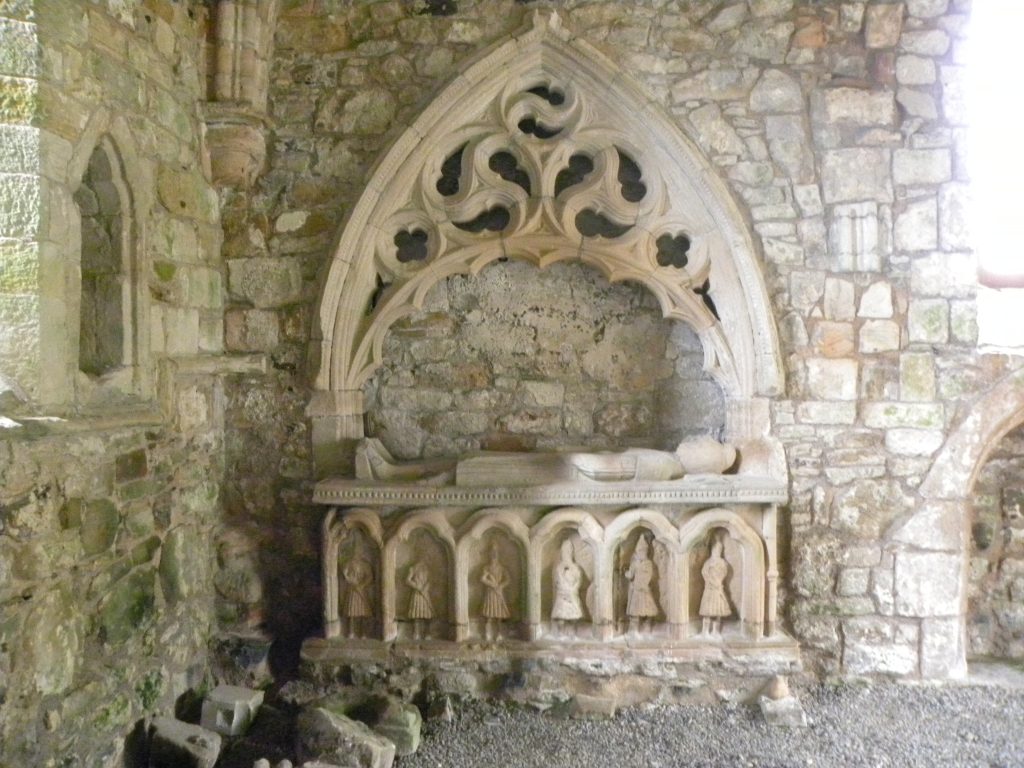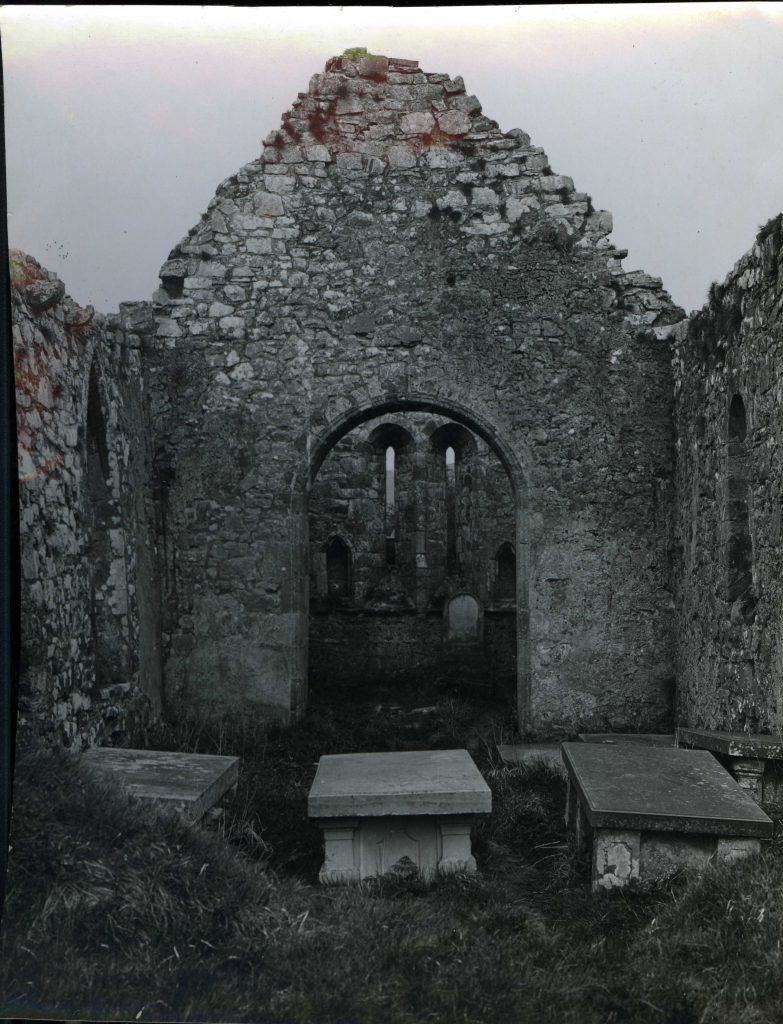7. The Priory of Dungiven

6. Drumceatt
6th March 2023
8. Dunseverick
6th March 20237. The Priory of Dungiven
The priory stands on the site of early churches founded in the 5th and 7th centuries. The O’Cahans invited the monks of the Augustinian Order to found a monastery here in the early 1100s.
Within the priory is a magnificent tomb, said to be that of Cooey-na-Gal O’Cahan, decorated with images of gallowglasses, Scottish mercenaries. Sons of Scottish and French nobility and royalty came here to be educated both academically and militarily.
The legendary, Finvola the Gem of the Roe, is interred somewhere in the surrounding graveyard.
The Priory of Dungiven
By Jim Hunter
Dungiven Priory is built on a promontory overlooking the River Roe. St Nechtan, who died in 679 AD, is linked with the establishment of the first church, although there is a strong tradition that St Patrick founded the church in the 5th century. There are no traces of these churches, as they were built of wattle and wood. During the early 1100s Dermot O’Cahan, the chieftain or petty king of the O’Cahans, invited the monks of the Augustinian Order to found a monastery at Dungiven on the site of an earlier church constructed by the O’Cahans.

The exterior of Dungiven Priory. Courtesy of the Sam Henry Collection.
The ruins display work over many periods indicating a long and complex history. The earliest part of the Church is the nave, which originally stood alone. The Chancel was added in the 13th century. The most striking feature of the Chancel is the magnificent tomb of Cooey-na-Gall O’Cahan, who died in 1385. There is limited visibility of the tomb, which is now only visible through a locked entrance with a wire mesh window. The tomb is decorated with a quilted guard on top and six Scottish warriors, ‘gallowglasses’ on the front. The tomb is a reminder of the strong links with the MacDonalds of the Western Highlands.

The tomb of Cooey-na-Gall O’Cahan.
Over the years the Priory had become famous for its teaching, and students came from as far away as Scotland and France. Education was not confined to academic subjects but included training in the use of weapons. At some time in the later Middle Ages, a four-storey tower was added to the nave but only the base remains. After the Dissolution of the Monasteries, from the mid-1530s onwards, it was held by the O’Cahans as a military stronghold.
At the conclusion of the Nine Years War in 1603, the O’Cahans lost control of their lands, and Donal Ballagh O’Cahan, the last of the O’Cahan chieftains was accused of treason. He was arrested, taken to Dublin and eventually imprisoned in the Tower of London, where he died in 1618. During the Plantation of Ulster, the territory around Dungiven was allocated to the Skinners’ Company of London.

The interior of Dungiven Priory. Courtesy of the Sam Henry Collection.
Their agent, Sir Edward Doddington, built an English-style house next to the church and refurbished the nave for Church of Ireland worship. He also repaired and occupied the Tower. Excavation has shown that the house became derelict and was burned down in the late 1600s. It was Doddington who established the town of Dungiven. According to a Survey by Pynnar, he had built twelve houses by 1618 located not far from the site of the present town. He brought English and Scottish tradesmen and their families to settle in the town.
Finvola – The Gem of the Roe

Statue of Finvola – the Gem of the Roe, Main Street, Dungiven.
A local legend tells the story of Finvola, the Gem of the Roe. Dermot O’Cahan and his daughter Finvola, were visiting Scotland and on their way home their boat was blown onto the island of Islay, the headquarters of the MacDonalds, the Lords of the Isles. They were accorded great hospitality and while they were on the island Angus, the son of the MacDonald chieftain, was very much taken by the beauty of Finvola. After their departure for Dungiven, Angus was unable to settle down and he eventually confided to his father of his love for Finvola. His father persuaded him to go to Dungiven and ask Dermot for his daughter’s hand in marriage. Dermot agreed on the condition that Angus should send back her body on death for burial in Ireland, as he didn’t want her to be buried in a foreign land. Angus and Finvola set off for Islay but ‘short was the fond years these lovers did share’. Finvola died young and Angus could not bear the thought of sending her body back to Dungiven so he buried her on Islay. The O’Cahans would never have known anything about her death but for Gráinne Rua, the family banshee, who wailed and lamented her death. The O’Cahans decided to mount an expedition against the MacDonalds and claim back Finvola. On their arrival on Islay, Angus intervened saying that he was to blame and that he did not want warfare over this. He admitted that his only fault was that he loved her so much that he couldn’t part with her body. He gave back Finvola’s body to Dermot, who took it back for burial in Dungiven.
No one knows where Finvola is buried but legend has it that she was interred somewhere at the Priory. There is also confusion as to the identity of Finvola. Dermot O’Cahan (died 1428) had a daughter called Finvola but she married a McSweeny from Donegal. A century later there was another chieftain called Dermot, who had a daughter who married Angus MacDonald from the Isles, but she was called Agnes. Perhaps the legend is drawn from both.

Finvola The Gem of the Roe. From the Sam Henry Collection.
Directions
The site can also be accessed from Bleach Green.
Co-ordinates: 54.9174, -6.9217
This project is receiving financial support via the District Council Good Relations Programme.


